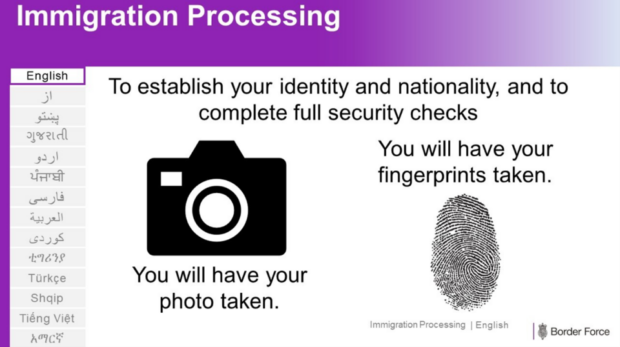
The Home Office is the lead government department for immigration, visas, passports and asylum in the United Kingdom ('the UK'). The people we serve might be new to the country or accessing our services from overseas.
Not all of them will speak English. And those who do may still be learning.
For this reason, the Home Office offers interpreters and translations for some of our services. Our digital products aim to provide non-digital alternatives for those who want to speak to a person.
But the majority of our content is written in English, and this presents an obvious challenge for many of our users.
Using understandable language ensures everyone has equal access to critical government services and also reduces inequalities and protects people's rights.
Tips for writing for people who do not understand English
At Home Office Digital, Data and Technology we’ve been designing with language barriers in mind for a while now.
Back in 2015, our colleagues Amanda Summers-Plotno and Ben Stevens wrote a blog on writing for non-native English speakers. But a lot has happened in the UK government and internationally since then.
We have built on that guidance and used our recent experiences to put together some tips for anyone who needs to design for people with limited English.
More detail is given in our guide to designing for users with limited English, available on the Home Office Design System.
Be really clear and concise
Reading and understanding information is much slower if you have limited English.
People may interact with the Home Office at stressful times in their life, which already affects comprehension. Research has also shown that long and technical content makes people anxious.
This makes the use of clear language really important.
And though you already do this across all your services, you may have to be even plainer than you think. Here are some words we have discovered limited English speakers find hard to understand:
- deadline
- get in touch
- partner
- dependant
Testing is really important in these cases.
Consider images or videos
Before you even start to write, consider if an image, diagram or video is more useful.
A study has shown that a combination of pictures and text can help language learners to understand and remember information.
In a recent discovery, we explored using images in signage at a Home Office building as many people reading the signs did not speak any English.

We have also used a similar approach with passports – a chip symbol is included with the text describing what it is.

It’s important to remember that not all users can perceive images so text alternatives should always be available.
Define and explain
Sometimes you may have to use specialist or technical words because of policy or legal constraints. If so, give examples or explain what something is.
For example, ‘Biometrics means your fingerprints and a photograph of your face’. Or ‘Chaperone means an adult who is travelling with your child’.
Similarly, you might want to tell them why we need something. For example, why we are asking for any disabilities or health conditions.
Keep sentences short and simple
People learning a language read every word, sometimes stopping to translate. This is different to fluent speakers who skim read.
Make this easier for limited English speakers by keeping sentences short and simple.
We advise following Content Design London’s Readability Guidelines recommendation to keep sentences to an average of 15 words, if you can.
If you cannot, the Government Digital Service advice is to keep your sentences to an average of 25 words.
Split long sentences into different sentences or use lists. You can also save words by using simpler verbs, like ‘Complete’ rather than ‘You should complete’.
Be careful with tense as well. The simple present (‘You do’) and simple past tense (‘You did’) can help with comprehension and simplicity. These are often the first tenses that language learners are taught.
Try to avoid the perfect tense (‘I will have been’) and make sure you only use the future tense (‘I will’) if you need to. For example, the phrase ‘How your information will be used’ can be easily rewritten in the present ‘How we use your information’. And it makes it active, which is also great for this user group.
Use words that translate well
Not all words translate exactly.
We’ve found that the word ‘deadline’ is translated as ‘dead’ and ‘line’. Much more alarming than what we mean.
Similarly, avoid words that have a double meaning in English. Take the word ‘leave’, for example. Within the Home Office we sometimes use this to mean ‘permission’ but the user or a translating tool may read it as ‘go away’.
Avoid idioms
Idiomatic and figurative language is common and easy to use by accident.
But those less familiar with English may take idioms literally.
Think about phrases like ‘Get in touch’. This may be misunderstood when taken literally.
English speakers might also use phrases like ‘keep an eye out’ to mean ‘expect to see something soon’ - that is a strange phrase when translated literally.
Be as clear as you can. For example, in recent research with an asylum intake centre we found users were being directed to a ‘red tent’. This tent was not red at all. The centre they were in had been organised into zones, and ‘red’ was just the name of the zone.
Spell out abbreviations and acronyms
Abbreviations and acronyms don’t translate well. Translator tools don’t pick them up.
Even if you expand on first use, the translation may not match the initials (for example ‘biometric residence permit (BRP) becomes ‘permesso di soggiorno biometrico (BRP)’ in Italian) so it is harder for the reader to recognise the acronym on later screens.
Abbreviating through punctuation can also puzzle limited English speakers. A forward slash (/) could represent division or show a strong connection between words. For example, if you ask users about their ‘parent / legal guardian’, they might not realise this means ‘parent or legal guardian’.
Words have power
And finally, in our last blog we used the term ‘non-native speakers’. We now want to avoid that term as it reduces people to what they are not, and the word ‘native’ has links to the British colonial past.
There’s no space to cover the debate in this post, but many other organisations are looking into this and have suggested alternatives, for example, the British Council in their article ‘Native speakerism’.
It has been difficult to find a single descriptive alternative, and maybe that’s ok. You will see we describe it mostly according to the language level – for example using words like ‘limited’ or 'fluent’.
This is a good example of how words can reinforce stereotypes or inequality. At the Home Office, we are committed to our values of being collaborative, compassionate, courageous and respectful. Using language that empowers and respects language and cultural difference is an important part of that.
Help us improve our guidance
This post is based on our guidance on designing for people with limited English. We are always looking to iterate it.
If you have any insights or examples that you would like to share, please contact ucdops@homeoffice.gov.uk.

2 comments
Comment by Paul posted on
This is a fantastic blog that I wish I had read 15 years ago when I was writing asylum decision letters as a New Asylum Model (NAM) asylum caseworker and using words such as "ergo" or "henceforth" in them because I thought letters from Government needed to sound official and as though they were written by The Queen or Shakespeare themselves!!!! Haha!!
Comment by Kat posted on
This is very interesting and there are some things that I hadn't considered. I think that guidelines like these can also help Neurodiverse people too. For example, ADHDers may find that short sentences and paragraphs help understanding. Idioms and ambiguity can also be challenging for Autistic people.